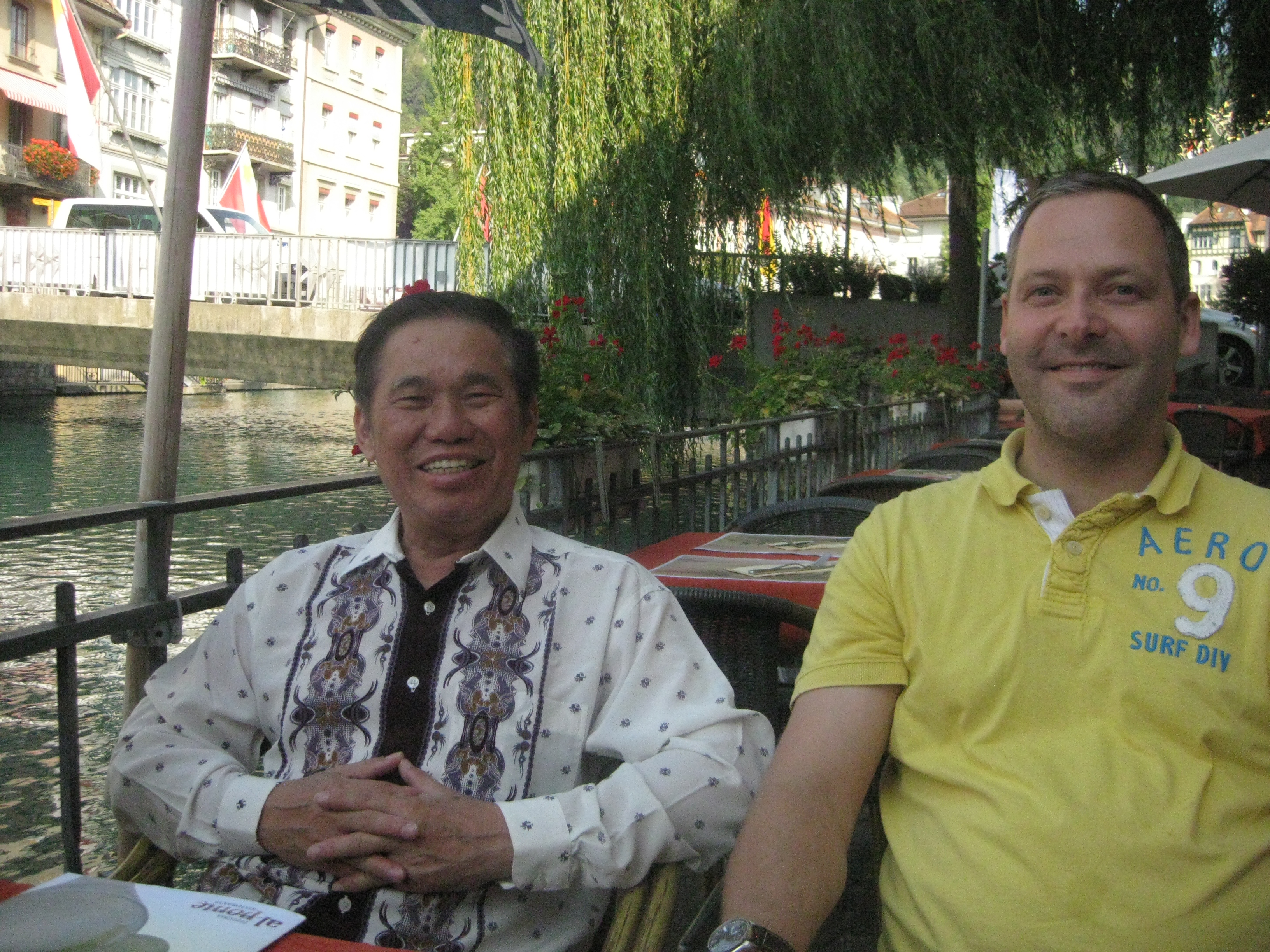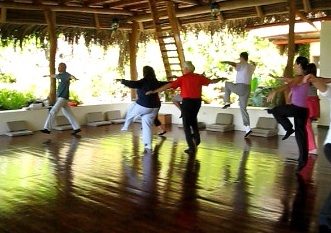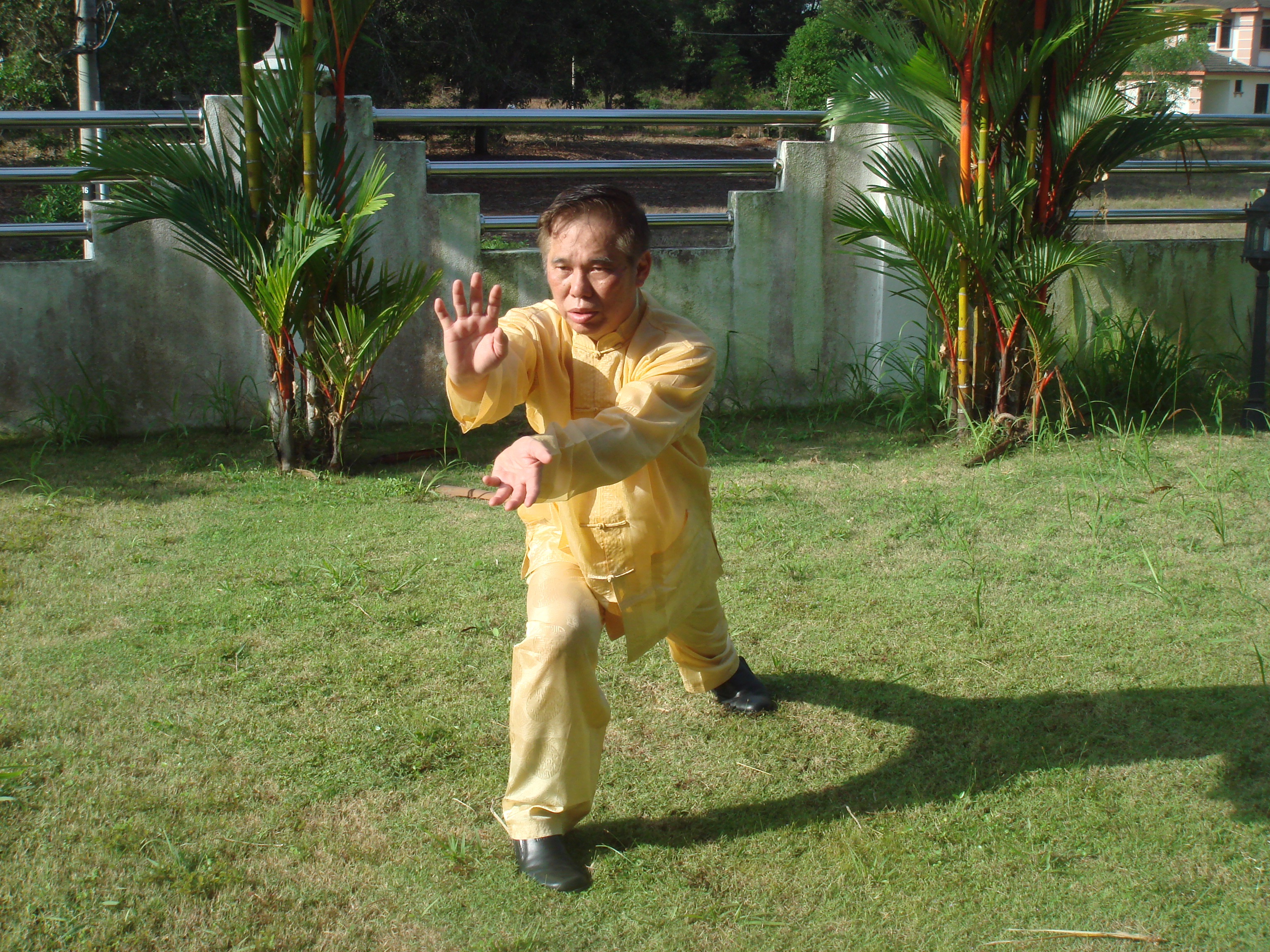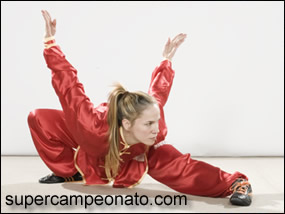SELECTION OF QUESTIONS AND ANSWERS
APRIL 2013 PART 3

Manifesting good health and vitality, Grandmaster Wong Kiew Kit and Sifu Roland Mastel in the beautiful Swiss town of Thun enjoying a meaningful, rewarding life
Question 1
How does one become a better Buddhist? .
— Irina, Germany
Answer
First, let us be clear what a Buddhist is. A Buddhist is one who follows the teaching of the Buddha. What is the teaching of the Buddha?
According to the Buddha himself, his teaching is summed up in three phrases:
- Avoid evil.
- Do good.
- Cultivate the mind.
In some cultures, "mind" refers to the spirit, soul, heart or consciousness.
Hence, anyone who avoids evil, does good and cultivates his mind, spirit, soul, heart or consciousness is a Buddhist.
It is also meaningful to know that "Buddha" means the Enlightened One. To many people, the Enlightened One in this world in this era is Sidhartha Guatama. To many other people, the Enlightened One is Jesus Chris, Prophet Mohammad, Moses or Lao Tzu.
Thus, to be a better Buddhist means to be better in avoiding evil, doing good and cultivating the mind. If you, for example, used to have negative thoughts, which is doing evil as negative thoughts bring harm to others and yourself, but now you don't, you have become a better Buddhist. If you used to be depressed, which is harmful to the spirit, but now you are relaxed and peaceful, you have become a better Buddhist.
Question 2
You often talk about a meaningful, rewarding life for ourselves and other people. What is a meaningful, rewarding life?
Answer
Different people may interpret a meaningful, rewarding life differently.
Most women will regard a meaningful, rewarding life as being happily married and have loving children. Most men will regard a meaningful, rewarding life as being successful in public and in private.
Some people may consider a meaningful, rewarding life as contributing to the welfare of society.
We require certain conditions to lead a meaningful, rewarding life. We need to be healthy, to have vitality and mental clarity as well as some wisdom.
It is difficult even to live life normally when one is not healthy. We need vitality and mental clarity to carry out the tasks required for a meaningful, rewarding life. We also need wisdom to choose and act appropriately.

Crane Flying through Clouds, manifesting the yin-yang harmony of solidness and agility
Question 3
When a practitioner is solid in his stance but does not move fast, we refer to this as a weakness of double yang. When a practitioner is fast but has no force, we also refer to it as a weakness of double yang. Why is it not a weakness of double yin?
— Santiago, Mexico
Answer
Yin and yang are symbols, and as symbols they may represent different things in different contexts. By convention, what is obvious is represented by yang, and what is not obvious is represented by yin.
In the context of a person being solid and not moving fast, these two aspects are obvious, and are represented by yang. Hence, we refer to his setback as a weakness of double yang.
When you stay at your stance, you are very solid. If someone were to attack you, but this has not happened yet, you could move very fast. The hidden part, your ability to move fast despite being very solid, is represented by yin. In this case, you have yin-yang harmony, even when your ability to move fast has not been tested out yet.
Now someone actually attacks you, and you move fast despite originally you were at a solid stance. So now both your solidness and agility are obvious. Do we still call this yin-yang harmony, or the strength of double yang?
We call it yin-yang harmony. In this new context, yin and yang do not represent the non-obvious and the obvious; they represent agility and solidness.
Similarly when a person is fast and has no force, we refer to the situation as a weakness of double yang, regardless of whether before or after his lack of force has been acted out. It is because it is common, and therefore obvious, that when people are fast they have little or no force.
If you are fast and also forceful, or you are forceful and also fast, in both cases you have yin-yang harmony.
Question 4
I'm curious about your course and wondered if I could gain your advice please?
I've practiced a form of energy work since I was about 7 years old. Nothing in the home life taught me this. I simply liked playing with the 'tingles'. I could make this go up my spine and get warmth all over.
As I got older I learnt to use it create healing in others. This came after reading at 13 about healing. It gave me the idea that I could put it in others and make something happen. I succeeded and did this many times with considerable success.
In the last few years I realised that I could be more precise and use it the way folks do when doing Tai Chi. I have a little knowledge from books and would be interested to discuss this with someone who is an expert. Would you be willing to help?
— Robert, UK
Answer
It is unwise to play around with qi when you are untrained. You may have some pleasant surprises or even a little success, but it is easy to be deviated which result in harm and yet not know about it.
If you are not trained to heal, it is unethical to heal others even when your intention is good. You may cause a lot of harm to others as well as to yourself.
Frankly, I am not interested to waist my time discussing chi or energy with you when you have little or no understanding and experience of it. But if you are sincere and want to learn, I can help you. Just apply for my Intensive Chi Kung Course. Please note that application does not necessarily mean acceptance. You will be informed if your application has been accepted. You can also find more details on my website.

Grandmaster Wong Kiew Kit demonstrating the famous Butterfly Palms of Shaolin Kungfu
Question 5
I am a 14 years old living in the United States. Your book, The Art of Shaolin Kung Fu, has been very interesting and knowledgeable to me. I am still currently learning from your book.
— Reyes, USA
Answer
I am glad you enjoy and have benefited from my book.
Shaolin Kungfu is a wonderful art, but you must learn from a genuine Shaolin master. Nowadays it is very hard to find genuine masters teaching genuine Shaolin Kungfu.
How do you find out whether it is genuine Shaolin Kungfu? An effective way is to find out whether what is being taught corresponds to what genuine Shaolin Kungfu offers.
There are three important things practicing genuine Shaolin Kungfu will give you, namely good health, combat efficiency and spiritual joys. If you gain these benefits, then what you practice is genuine. If you become more and more unhealthy, use kick-boxing instead of Shaolin techniques for sparring, and become angry and stressful, then what you practice is not genuine.
Question 6
Your book has actually gotten me interested in the Shaolin Temple, and now I am planning on going there after I finish my education. I am wondering what to expect when I get there.
Answer
The Shaolin Temple in China today is very different from the Shaolin Temple in the past. In the past the Shaolin Temple was an imperial temple where high-level kungfu, chi kung and Zen were taught. Now it is more of a tourist center.
Traditional Shaolin Kungfu is no longer taught in the Shaolin Temple today. But if you wish to practice modern wushu, which is different from traditional Shaolin Kungfu, you may find modern Shaolin monks teaching in numerous wushu schools around the Shaolin Temple today.
You can also learn high-level wushu in the United States. But please bear in mind that modern wushu is different from the traditional Shaolin Kungfu I have described in my books.

A beautiful wushu demonstration reproduced from http://www.supercampeonato.com/artes-marciales/el-kung-fu-wushu.php
Question 7
Will they train me? Is there payment required? Is it a life-long membership? I just am not sure.
Answer
The modern Shaolin monks or wushu instructors will train you. Yes, you have to pay fees for the training. It is not a life-long membership. You may leave whenever you want.
Question 8
Who better to ask but you, a Grandmaster, who has trained there. Thank you for your time. I am very honored to be in contact with such a highly ranked martial artist.
Answer
I did not train at the modern Shaolin Temple which is in the Henan Province in north China.
My great grandmasters, the Venerable Jiang Nan and the Venerable Chee Seen, trained at the southern Shaolin Temple in Quanzhou and on the Nine-Lotus Mountain respectively in south China before they were razed to the ground by the Qing Army. These two great grandmasters passed the Shaolin arts to us.
The northern Shaolin Temple in Henan was not burnt during the Qing Dynasty. It was burnt in 1928, 17 years after the Qing Dynasty was overthrown, and its burning had nothing to do with kungfu. It was burnt by rival warlords using cannons and guns.
LINKS
Selected Reading
- Instructor-Student Relationship
- My Life Changing Experiences
- Tiger-Crane Double-Form Set
- Entering Tao
- An Incredible Experience
